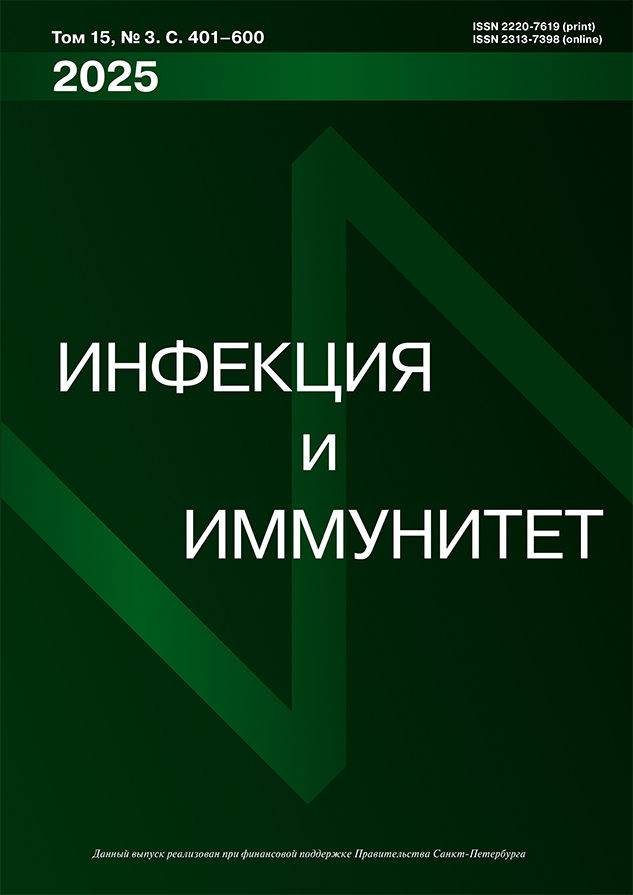ASSESSING A POSSIBILITY OF USING ATOMIC EMISSION SPECTROMETRY FOR HYPERMUCOID KLEBSIELLA DIFFERENTIATION
- Authors: Bikanova M.1, Zakharova Y.V.1, Sukhikh A.S.1
-
Affiliations:
- Kemerovo State Medical University Medical Institute
- Section: SHORT COMMUNICATIONS
- Submitted: 05.09.2025
- Accepted: 27.09.2025
- URL: https://iimmun.ru/iimm/article/view/18002
- DOI: https://doi.org/10.15789/2220-7619-AAP-18002
- ID: 18002
Cite item
Full Text
Abstract
Various spectrometry (time-of-flight mass spectrometry, Raman spectrometry) types are used in the identification of microbial strains. Atomic emission spectrometry allows for the evaluation of the elemental sample composition, which can also be used in laboratory practice, because bacterial cells with different biological properties exert unique composition.
Purpose. To determine the elemental composition of hypermucoid Klebsiella pneumoniae in order to identify AES-markers promising for differentiating various Klebsiella subpopulations.
Materials and methods. The elemental composition of 30 Klebsiella pneumoniae strains isolated from the sputum of intensive care unit patients was studied. All Klebsiella strains were isolated from sputum in etiologically significant quantities, followed by verification with RealBest DNA Klebsiella pneumoniae/Pseudomonas aeruginosa (kit 1) commercial test system (Vector Best, Russia). The study design was presented as a one-time study: group 1 –hypermucoid K.pneumoniae (n=12), group 2 – classic K.pneumoniae (n=18). The hypermucoid phenotype of the strains was determined using the string test. The content of elements was studied using an AES-ISP 9820 atomic emission spectrometer with inductively coupled plasma (Shimadzu, Japan), pre-automated sample preparation using a TOPEX+ (PreeKem Ltd, China). The data are presented as percentages by mass with a 95% confidence interval. The χ2 test was used to compare the relative numbers. Differences were considered statistically significant at p < 0.05.
Results. In Klebsiella with hypermucoid colony phenotype, the elemental mass fraction was found as follows: nickel – 7.5 times (χ2(1)=14.8, p=0.0001), manganese – 4 times (χ2(1)=8.475, p=0.0036), iron – 2.6 times (χ2(1)=10.25, p=0.0014), potassium – 2 times (χ2(1)=67.39, p=0.0001), sulfur – 1.5 times (χ2(1)= 33.27, p=0.0001), copper – 1.4 times (χ2(1)=4.784, p=0.03) higher than that of classical strains. The identified features of the elemental composition indirectly evidence about physiological characteristics of this Klebsiella subpopulation.
Conclusion. Inductively coupled plasma atomic emission spectroscopy allowed to identify the elemental composition of slime-forming K.pneumoniae, which makes this method promising for differentiating between "classic" and "hypermucoid" Klebsiella subpopulations. Nickel, manganese, and iron may be considered promising AES-markers.
About the authors
Maria Bikanova
Kemerovo State Medical University Medical Institute
Email: bmg1321@mail.ru
ORCID iD: 0000-0001-7482-4887
Senior Lecturer at the Department of Microbiology and Virology
РоссияYuliyа V. Zakharova
Kemerovo State Medical University Medical Institute
Email: yvz@bk.ru
ORCID iD: 0000-0002-3475-9125
SPIN-code: 5272-4787
MD, PhD, Professor, Department of Microbiology and Virology
Россия, 22а, Voroshilova Street, Kemerovo, 650056Andrey S. Sukhikh
Kemerovo State Medical University Medical Institute
Author for correspondence.
Email: suhih_as@list.ru
ORCID iD: 0000-0001-9300-5334
SPIN-code: 6427-5667
PhD in Pharmacy, Associate Professor, Head of the Laboratory of Physical and Chemical Research of Physiologically Active and Natural Compounds
Россия, Кемеровская область, г. Кемерово, ул. Красная, д.6References
- Полибин Р.В., Брусина Е.Б., Ковалишена О.В., Глушков Е.В., Гридина А.А., Асланов Б.И., Брико Н.И. Эпидемиологическое межрегиональное многоцентровое исследование инфекций, связанных с оказанием медицинской помощи, в отделениях реанимации и интенсивной терапии (ЭММИ). Первые результаты // Эпидемиология и Вакцинопрофилактика. 2025. Том 24, №1. С. 4-9. Polibin R.V., Brusina E.B., Kovalishena O.V., Glushkova E.V., Gridina A.A., Aslanov B.I., Briko N.I. Epidemiological Interregional Multicenter Study of Healthcare-Associated Infections in the Intensive Care Units. First Results. Epidemiology and Vaccinal Prevention, 2025, vol. 24, no 1. pp. 4-9. https://doi.org/10.31631/2073-3046-2025-24-1-4-9
- [doi: 10.31631/2073-3046-2025-24-1-4-9].
- Садовников Е.Е., Поцелуев Н.Ю., Барбараш О.Л., Брусина Е.Б. Эпидемиологические особенности инфекций, связанных с оказанием медицинской помощи, в кардиохирургии. Фундаментальная и клиническая медицина // 2023. Том. 8, № 4. С. 73-84. Sadovnikov E.E., Potseluev N.Yu., Barbarash O.L., Brusina E.B. Healthcare-associated infections in cardiac surgery: epidemiological features. Fundamental and Clinical Medicine, 2023, vol. 8, no 4, pp. 73-84. https://doi.org/10.23946/2500-0764-2023-8-4-73-84
- Самойлова А.А., Краева Л.А., Михайлов Н.В., Саитова А.Т., Полев Д.Е., Вашукова М.А., Гордеева С.А., Смирнова Е.В., Белятич Л.И., Долгова А.С., Шабалина А.В. Геномный анализ вирулентности и антибиотикорезистентности штаммов Klebsiella pneumoniae // Инфекция и иммунитет. 2024. Т. 14. №2. C. 339-350. Samoilova A.A., Kraeva L.A., Mikhailov N.V., Saitova A.T., Polev D.E., Vashukova M.A., Gordeeva S.A., Smirnova E.V., Beljatich L.I., Dolgova A.S., Shabalina A.V. Genomic analysis of Klebsiella pneumoniae strains virulence and antibiotic resistance. Russian Journal of Infection and Immunity, 2024, vol. 14. no. 2, p. 339-350. https://iimmun.ru/iimm/article/view/15645/2038
- [doi: 10.15789/2220-7619-GAO-15645]
- Chen Ju, Li J., Huang F., Fang J., Cao Y., Zhang K., Zhou H., Cai J., Cui W., Chen Ch., Zhang G. Clinical characteristics, risk factors and outcomes of Klebsiella pneumoniae pneumonia developing secondary Klebsiella pneumoniae bloodstream infection. BMC Pulmonary Medicine, 2023, vol. 23, no. 1, pp. 102 – 113. - https://doi.org/10.1186/s12890-023-02394-8
- Chu H.W., Tan Y.H., Chen Y., Yong M., Lye D.C., Kalimuddin Sh., Archuleta S., Gan Y-H. Acquisition of regulator on virulence plasmid of hypervirelent Klebsiella allows bacterial lifestyle swich in response to iron, mBio, 2023, vol. 14, no.4, e 0129723. - https://doi.org/10.1128/mbio.01297-23
- [doi: 10.1128/mbio.01297-23]
- German N, Lüthje F, Hao X., Ronn R., Rensing C. Microbial virulence and interactions with metals. Progress in Molecular Biology and Translational Science, 2016, vol. 142, pp.27-49. - https://pubmed.ncbi.nlm.nih.gov/27571691/
- [doi: 10.1016/bs.pmbts.2016.05.010.]
- Kijineh B., Alemeyhu T., Mengistu M., Mohammed Ali M. Prevalence of phenotypic multi-drug resistant Klebsiella species recovered from different human specimens in Ethiopia: A systematic review and meta-analysis. PLoS ONE, 2024, vol. 19, no. 2. p. e0297407. - https://journals.plos.org/plosone/article?id=10.1371/journal.pone.0297407
- [doi: 10.1371/journal.pone.0297407]
- Orzel B, Pelucelli A, Ostrowska M., Potocki S., Kozlowski H., Peana M., Gunzienna-Kontecka E. Fe(II), Mn(II), and Zn(II) binding to the C-terminal region of FeoB protein: an insight into the coordination chemistry and specificity of the Escherichia coli Fe(II) transporter. Inorganic Chemistry, 2023, vol. 62, no. 45, pp. 18607-18624. - https://doi.org/10.1021/acs.inorgchem.3c02910
- [doi: 10.1021/acs.inorgchem.3c02910.]
- Tiwari V, Sharma A, Braga R., Garcia E., Appiah R., Fleeman R., Abuaita B.N., Patrauchan M., Doerrler W. T. Klebsiella pneumoniae DedA family proteins have redundant roles in divalent cation homeostasis and resistance to phagocytosis. Microbiology Spectrum, 2024, vol. 12, no. 2, e0380723. - https://doi.org/10.1128/spectrum.03807-23
- [doi: 10.1128/spectrum.03807-23. Epub 2024 Jan 12.]
Supplementary files






